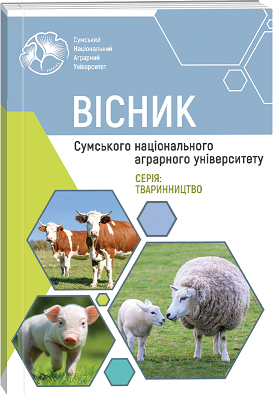FEEDING QUALITIES OF PIGS OF DIFFERENT GENOTYPES
Abstract
The article examines the results of studies of the fattening qualities of pigs of different productivity directions at three levels of fattening. The study was conducted on purebred pigs of the large white, Myrhorod, Poltava meat breeds, Landras and red and white-belted breeds. The fattening qualities of young animals were studied according to indicators of average daily growth during the fattening period, the age at which the animals reached a live weight of 100 and 125 kg, and feed consumption per 1 kg of growth. The first level provided for fattening typical for many farms at the level of 250–350 g of average daily gains. The second and third levels of fattening were carried out with average daily gains of 600–800 and 800–1000 g, respectively. Under purebred breeding, when fattening pigs according to the rations typical for many farms, animals of the Myrhorod breed were the best in terms of fattening qualities. The regularity established when fattening animals up to 100 kg mainly took place when fattening up to 125 kg of live weight. In conditions of intensive pork production, one of the main factors determining the efficiency of the industry is the genetic potential of pig breeds and the degree of its realization. Complete feeding contributed to the realization of the genetic potential of fattening qualities of meat animals. With average daily gains of 600–800 g, among the five studied genotypes, the best in terms of age of reaching a live weight of 100 kg were animals of the red and white-belted breed and landraces. They also had the highest average daily fattening gains and consumed the least amount of feed per unit of gain. At an intensive level of fattening, piglets of the meat sector turned out to be the best in terms of fattening qualities. The increase in average daily gains during fattening made it possible to reveal the advantages of meat genotypes over the large white and Mirgorod breeds in terms of average daily gains, feed consumption and time to reach the necessary slaughter conditions. Studies have shown that an increase in final live weight during fattening from 100 to 125 kg is accompanied by a natural extension of time and a noticeable increase in feed costs per unit of gain.
References
2. Vdovenko, N. M., Hryshchenko N. P., Shepeliev V. S. (2017). Rehuliuvannia rynku svynyny Ukrainy v umovakh yevrointehratsii [Regulation of the pork market of Ukraine in the conditions of European integration]. Kiev : Kondor (in Ukrainian)
3. Voitenko, S. L. (2012). Henezys myrhorodskoi porody svynei. [The genesis of the Myrhorod breed of pigs]. Poltava (in Ukrainian)
4. Herasymov, V. I., Baranovskyi, D. I., Khokhlov, A.M., Rybalko, V. P., ta inshi. (2010). Tekhnolohiia vyrobnytstva produktsii svynarstva [Production technology of pig farming products]. Kharkiv : Espada (in Ukrainian)
5. Hlavatchuk, V. A. (2020). Efektyvnist vykorystannia fermentnoi kompozytsii «Danamiks» v hodivli molodniaku [Effectiveness of using the enzyme composition “Danamix” in feeding young pigs]. Vinnytsia (in Ukrainian).
6. Novhorodska, N. V., Ovsiienko, S. M., Solomon, A. M. (2021). Kormy, miaso, vyroby iz svynyny [Fodder, meat, pork products]. Vinnytsia : Druk (in Ukrainian).
7. Pelykh, V. H., Krupoder, M. S. (2020). Produktyvni yakosti svynei riznoho pokhodzhennia [Productive qualities of pigs of different origins]. Kherson (in Ukrainian).
8. Pelykh, V. H., Chernyshov, I. V., Levchenko, M. V. (2012). Henofond miasnykh porid ta perspektyvy yoho vykorystannia v svynarstvi [Gene pool of meat breeds and prospects of its use in pig breeding]. Kherson (in Ukrainian).
9. Pestushko, Ye. Ie., Pankieiev, S. P. (2018). Vykorystannia universalnykh porid svynei v umovakh svynarskykh pidpryiemstv stepovoi zony Ukrainy [The use of universal breeds of pigs in the conditions of pig enterprises of the steppe zone of Ukraine]. Kherson (in Ukrainian).
10. Huang, Y. H., Lee, Y. P., Yang, T. S. and Roan, S. W., 2003. Effects of Sire Breed on the Subsequent Reproductive Performances of Landrace Sows. Asian Australasian Journal of Animal Sciences, issue 16(4), p. 7. DOI: 10.5713/ajas.2003.489
11. Hagan, J., 2018. The effects of breed, season and parity on the reproductive performance of pigs reared under hot and humid environments. Tropical Animal Health and Production, issue 51(4), p. 52. DOI: 10.1007/s11250-018-1705-5
12. Knecht D., Srodon S. and Duziński K., 2015. Breed on selected reproductive performance parameters of sows. Arch. Anim. Breed, issue 58, pp. 49–56.
13. Šprysl M., Čítek J., Stupka R. [et al.] The significance of the effects influencing the reproductive performance in pigs. Re-search in pig breeding. 2012. Vol. 6(1), P. 54–58.
14. Sundruma, A., Aragona, A., Schulze-Langenhorstb, C., Bütferingb, L., Henningc, M. and Stalljohannb, G., 2011. Effects of feeding strategies, genotypes, sex, and birth weight on carcass and meat quality traits under organic pig production conditions. NJAS – Wageningen Journal of Life Sciences, issues 3–4, Vol. 58, pp. 163–172. DOI.org/10.1016/j.njas.2011.09.006
15. Ushakova S. Influence of boars of different breeds on reproductive qualities of sows in multipedigree crossbreeding. Visnyk Agrarnoi Nauky. 2016. Issue 94(2). R. 68–69.

 ISSN
ISSN  ISSN
ISSN 


